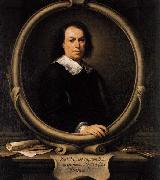Porslinet engros- Olja måleriet Engros- Måleriet Porslinet |
|||||||||||

|
|||||||||||
|
|
|
||||||||||||||
|
Bartolome Esteban Murillo
Spanish 1618-1682 Bartolome Esteban Murillo Galleries |
||||||||||||||
|
|
||||||||||||||
|
||||||||||||||
|
|
||||||||||||||
| Bartolome Esteban Murillo
Spanish 1618-1682 Bartolome Esteban Murillo Galleries 122 x 127 cm National Gallery, London The tablet beneath the fictive frame of this self portrait is inscribed in Latin: 'Bart [olo] m?Murillo portraying himself to fulfil the wishes and prayers of his children.' By 1670, when this portrait was probably painted, only four of Murillo's nine children were still living. His only daughter had entered a Dominican convent, and his youngest son was deciding on a career in the church; he was later to become a canon of Seville Cathedral. After the artist's death, the painting was engraved in Antwerp at the request of Murillo's friend Nicolas de Omazur, a Flemish poet and silk merchant established in Seville. The portrait itself borrows a device from Netherlandish engravings, much used in the frontispiece of books. A gilded oval frame, set against a wall on a shelf or console table, encloses Murillo's half-length likeness. But in a feat of legerdemain only possible in art, it is the painter himself, not his image, who paradoxically extends his hand beyond the frame. Dressed in sober black, with a soft lace collar at his throat, he looks at the viewer with a dignified and slightly melancholy air. Nothing within this portrait betrays that he is anything other than a gentleman. Around the frame, however, are disposed the tools of his profession: a palette laid out with paint, brushes, a drawing in red chalk, the chalk itself, a pair of dividers and a ruler. The white on the palette is a real, three-dimensional swirl of white lead paint, not the image of one. The dividers and ruler tell us that he is a learned artist, creating pictures according to the rules and proportions of mathematical laws and not merely imitating appearances. A drawing - the academic basis of all the visual arts - recalls that in 1660 Murillo co-founded the Academy of Seville of which he was the first president. As in all his portraits, in contrast to his other pictures, Murillo emphasises truthfulness above charm. Strong light, casting dark shadows, is used to model the forms, and his famous 'soft' brushwork is apparent only in the hair and lace. The sombre colour scheme of black, white and ochre is relieved only by red - as indicated on the palette, where its undiluted presence helps to clarify the spatial construction of the painting and enlivens its solemn play on the art of reality and the reality of art. |
||||||||||||||
|
Related Paintings to Bartolome Esteban Murillo :. |
||||||||||||||
|
|
||||||||||||||
|
|
||||||||||||||
|
KOMMA I KONTAKT MED Oss |







